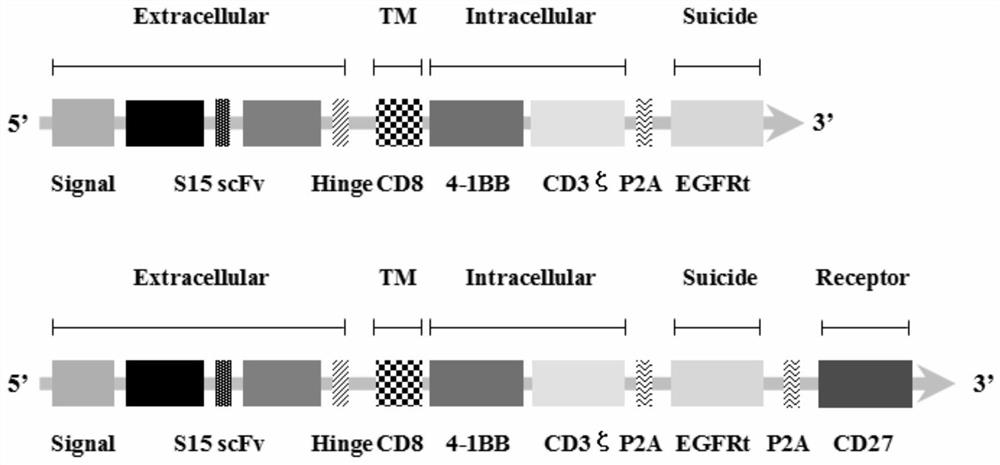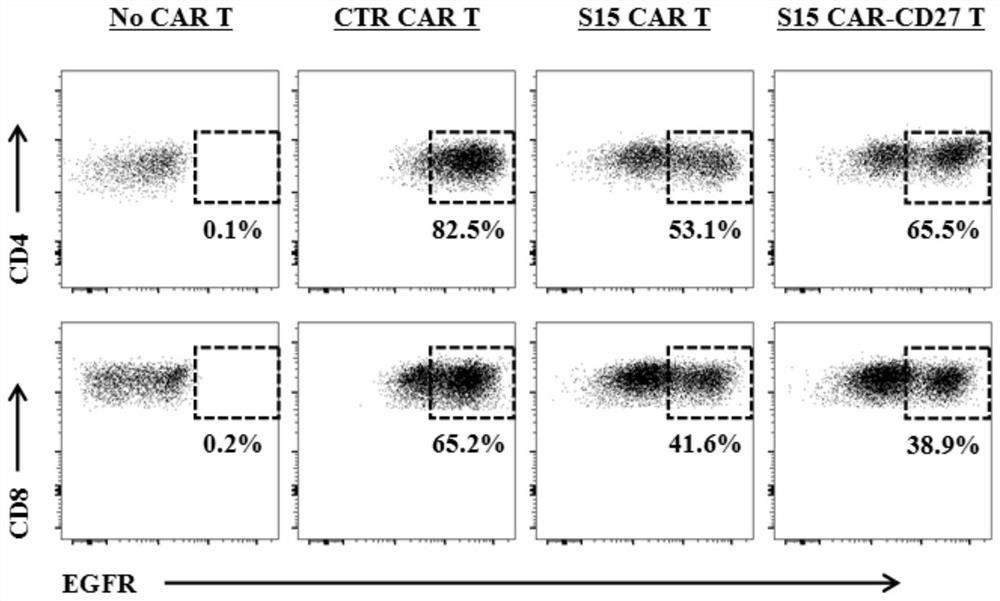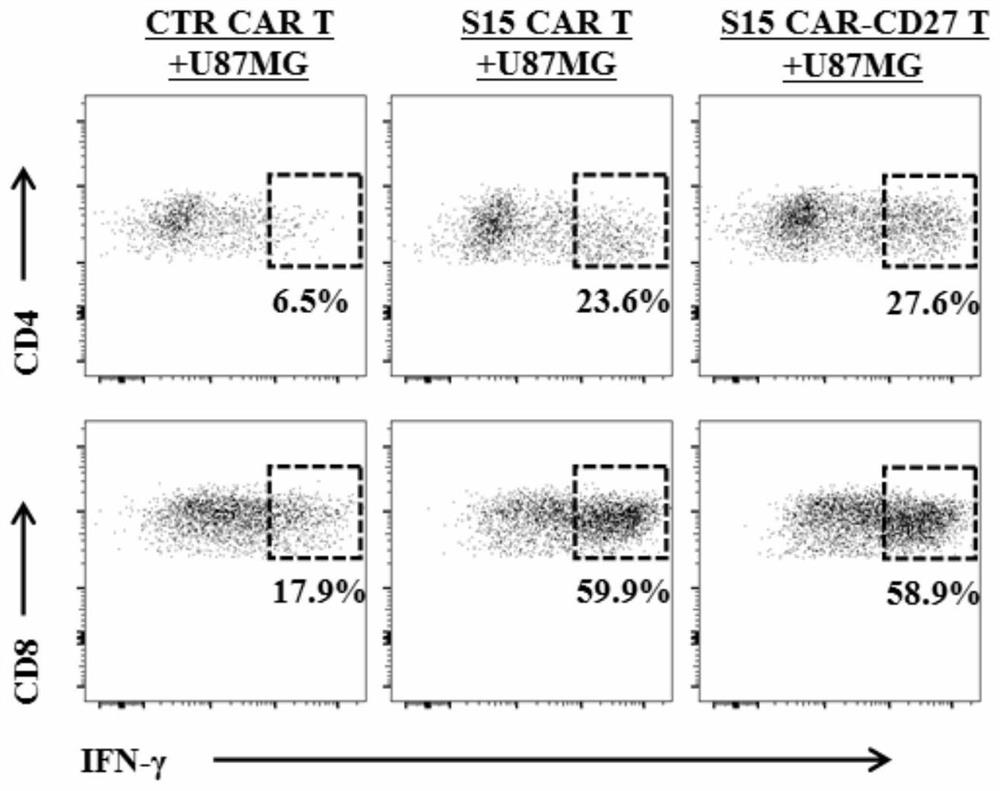Chimeric antigen receptor T lymphocyte and application thereof to preparation of product for treating solid tumors
A chimeric antigen receptor and cell technology, applied in the field of biomedicine, can solve the problems of no clinical efficacy, inability to truly exert anti-tumor effect, immune escape and other problems
- Summary
- Abstract
- Description
- Claims
- Application Information
AI Technical Summary
Problems solved by technology
Method used
Image
Examples
Embodiment 1
[0139] Example 1, Preparation of CAR-T cells
[0140] First, the construction of the reverse transcription viral vector
[0141] 1. Optimization of the full length sequence of wild-type CD27 gene cDNA
[0142] The full-length sequence of the wild-type CD27 gene cDNA is called NCD27. In order to make NCD 27 more suitable for expression in human cells, the NCD27 sequence is optimized on the website http: / / sg.idtdna.com / site in the case of ensuring NCD27 encoded, and obtains OCD27. The nucleotide sequence of OCD27 is shown in Seq ID No. 2719-3501.
[0143] 2, S15-CAR-CD27 gene sequence design and synthesis
[0144] The S15-CAR-CD27 gene sequence includes a coded gene sequence of human CD8 primary peptide, an encoded gene sequence of S15 SCFV, a coded gene sequence of human CD8 hinge transmembrane region, coding gene sequence of human 4-1bb, human CD3ζ Coding gene sequence, P2A peptide (rendered by P2A peptide-1) encoding gene sequence, CSF2RA signal peptide encoding gene sequence, EG...
Embodiment 2
[0184] Example 2, CFSE marker method Detection Car-T cells to tumor cell specific killing
[0185] CFSE (CFDA-SE) is a cell dyeing agent that can fluorescently labeled living cells, which can easily penetrate the cell membrane, covalently bind to intracellular proteins in living cells, and release green fluorescence after hydrolysis. Tumor cells can be labeled and quantified by CFSE labeling living cells, thus detecting killing efficiency of CAR-T cells on tumor target cells. The specific method is: the target cell isometric is divided into two groups, adjusted to the same cell density. The low concentration and high concentration CFSE were dyed, and the high concentration dyed target cells were co-cultured in a certain proportion of the non-stained immunocytes. After incubation for a period of time, high concentration staining target cell tubes (along with immune cells) were mixed with low concentration staining target cell tube. Finally, the killing rate of CAR T cells to target...
Embodiment 3
[0200] Example 3, tumor transplantation model detects tumor killing effect of Car-T cells in an animal
[0201] Experimental materials: 5-6 weeks old, a B-NDG of 18-22 g weight combined with immunodeficiency mice (Bai Oti Gene Biotechnology Co., Ltd.).
[0202] Experimental grouping: randomly divided experimental materials into three experimental groups, 5 mice each group. The method of processing each group is as follows:
[0203] S15 CAR-CD27 T: Temperature of B-NDG Temperamnamotic Mort-NDG U87-Mg Tumor Cell Solution (Solvent is PBS), with a inoculation amount of 0.3 ml (including 2 × 10 6 Tumor cells). After 5 days of inoculation of tumor cells, the S15 CAR-CD27 T cell solution prepared in the tail intravenous injection of Example 1 (PBS), S15 CAR-CD27 T cell injection is 0.2 ml (including 5 × 10 6 S15 CAR-CD27 T cells).
[0204] S15 Car T: Temperature of B-NDG inoculated with immunodeficiency mouse tail intravenous U87-Mg tumor cell solution (solvent is PBS), and inoculate 0.3...
PUM
 Login to View More
Login to View More Abstract
Description
Claims
Application Information
 Login to View More
Login to View More - R&D
- Intellectual Property
- Life Sciences
- Materials
- Tech Scout
- Unparalleled Data Quality
- Higher Quality Content
- 60% Fewer Hallucinations
Browse by: Latest US Patents, China's latest patents, Technical Efficacy Thesaurus, Application Domain, Technology Topic, Popular Technical Reports.
© 2025 PatSnap. All rights reserved.Legal|Privacy policy|Modern Slavery Act Transparency Statement|Sitemap|About US| Contact US: help@patsnap.com



